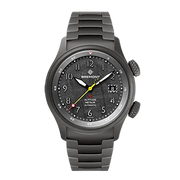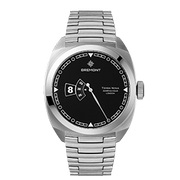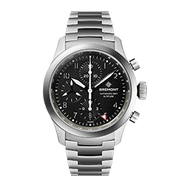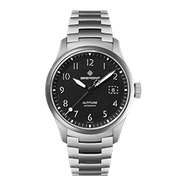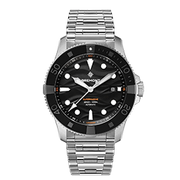Bremont has always prided itself on developing watches for those who embody humankind’s indomitable spirit of adventure and quest for excellence. From the depths of the oceans to the highest peaks and vast expanses of the skies – history has shown our unquenchable desire to test our limits and expand our horizons has seen some extraordinary individuals achieve remarkable milestones.
Some of the most impressive being Britain’s trailblazing female pilots – the pioneering aviators who helped shape the course of flying. Our precision-crafted collection of luxury ladies' watches is dedicated to this formidable mix of elegance and excellence, and the SOLO-34 range in particular is a tribute to two of the country’s most famous pilots, Amy Johnson and Lettice Curtis.
These exquisite timepieces also pay homage to the rich history of ladies’ timepieces. This fascinating evolution has seen women’s wristwatches become the ultimate fashion icon that today effortlessly blends form and function with flair and finesse.

Pioneering aviator Amy Johnson who famously flew her DH-60 Gypsy Moth from London to Australia
The origins of ladies’ watches
Historically men were the focus of new trends in fashion, as they had the wealth and opportunity to showcase these new items at important social gatherings. It may seem strange nowadays, but women’s fashion was often an afterthought for designers. Watches did not become popular for women until the last century.
When portable watches first became fashionable, they came in the form of the pocket watch. Watchmakers miniaturised clocks' mechanisms into pint-sized versions that could be slipped easily in and out of a pocket. Upper-class men took to wearing them; however, they were not practical for women, as their elaborate dresses didn’t feature pockets. Nevertheless, over time women felt like they needed their own timepiece and began to attach pocket watches to other accessories such as bracelets, necklaces and brooches.
From the realms of men’s pockets to the wrists of female aristocrats
Watch manufacturers took notice of this trend and soon began exploring designs for women’s wristwatches. The designers would also take orders for commissions and inspired many other watchmakers to focus on designing wristwatches which would appeal to the growing female market. It’s believed that the first ladies' watch was made in 1810 and consisted of a pocket watch which had been adapted to be connected to a bracelet and worn on the wrist. It was created for the Queen of Naples, Caroline Murat.
However, these early watches sported a significant price tag, making them inaccessible for anyone other than the wealthy and influential, such as the aristocrats of the European Royal Courts. From the Countess of Hungary to our very own beloved Queen Victoria – formidable women far and wide helped spread the word of this increasingly coveted component. Women’s wristwatches would only become mainstream towards the end of the 1800s, and they gradually became available to a more diverse market rather than merely the elite.
The early 1900s
By the start of the 1900s, many watch brands were designing wristwatches exclusively for their female customers. Although still regarded as luxury items, they were making a foray into the mass market. The 1920s saw the Art Deco era take hold, with watches inspired by these distinctive and beautiful designs. Dials often took a back seat to jewels and other decorative elements – which led to the creation of one of the smallest mechanical movements in the world, the Calibre 101. The desire for bold, opulent and expressive designs continued throughout the 1930s.
Often accompanying change in the world, the ability to navigate has been of huge importance and none more so than in the aviation era. Bremont Co-Founders, Nick and Giles English have aviation in their veins. As pilots themselves their love of flight was the first and strongest Bremont influence which can be seen throughout our collection. Whether our first watch the ALT1-C or the pivotal Wright Flyer Limited Edition, with material from the first flight in 1903. The brothers have celebrated aeronautical achievement in a multitude of ways.


In recognition of pioneering flight Bremont introduced the SOLO-32 AJ and SOLO-32 LC in March 2016, named after two of the world’s most respected pilots… Britain’s Amy Johnson became the first woman to fly solo from England to Australia in 1930, setting off a string of other outstanding records throughout her illustrious career. Bremont created the SOLO-34 AJ to commemorate Amy’s momentous flight in her DH-60 Gypsy Moth and to personify this tenacious and talented pilot’s contributions to the rich history of British aviation.
The Second World War produced one of the most inspirational figures in aviation, Lettice Curtis, the first woman to qualify to fly a four-engine Avro Lancaster bomber. Regarded as the best British female pilot in World War II, she was among the most skilled of only 11 women who had ever passed the test. She was also the longest-serving of the 168 wartime members of the Air Transport Auxiliary, flying various military combat aircraft. It was said Lettice could fly with a water-filled jam jar containing a goldfish on her passenger seat and land without spilling a drop. For Bremont Co-Founders and pilots Nick and Giles English, Lettice is a true inspiration, prompting the creation of the 34mm chronometer-rated SOLO-34 LC in her honour.
1950s to now
After the Second World War, there was a gradual return to more opulent wristwatches. The desire for a watch as a fashion accessory and display of status had returned. Significant developments in watchmaking and the wider availability of watches saw a positive trend in the desirability of the wristwatch again. From this period we have some of the most iconic watches in the industry and some of the world’s most iconic figures – Audrey Hepburn, for example, became one of the most recognised personalities and in her generation we see the focus on the actor and the watch – the style, the elegance, the icon – a wristwatch became recognised even more for what it was….and who was wearing it.
The playful and bold fashions of the 1960s were translated into watchmaking, and makers seized the opportunity to incorporate these design elements with practical time-telling functions. A dazzling variety of women’s wristwatches were created throughout the 60s, ranging from the most delicate bracelets to chunky cuff watches.
The 1970s and early 80s saw the introduction of the integral bracelet, the “his and hers” matching watch and the start of the ‘Quartz Crisis’, the upheaval in the horological industry caused by the advent of quartz watches that largely replaced mechanical watches worldwide.
The 1980s also saw practical yet elegant “business attire” watches became popular. By the 1990s, there was a decline in demand for wristwatches as modern technology meant people were surrounded by digital time-telling devices. Ironically this was also good news for watchmakers as both women and men now reverted to luxury mechanical timepieces that not only served a practical function but also exuded sophistication and conveyed a unique sense of style. Once again, tradition and timelessness would become the focus.
Ladies’ watches have played a pivotal role in the evolution of the modern watch industry as we now know it. In our modern era the lines are thankfully now blurred between the distinction of ladies and men’s watches to, mainly, smaller and larger watches.
As an example of this Carey Lohrenz, F-14 Tomcat Pilot and Leadership speaker is a Bremont ambassador who, after a highly successful Naval career, helps people in their respective management and goal driven environments operate at the highest level. Her watch of choice is the Bremont MBII, a 43mm purpose-built pilot watch worn by some of the most skilled aviators in the world.

Record-breaking mountaineer and Bremont ambassador Kristin Harila
Bremont takes great pride in working with the pioneers, adventurers and sportspeople who choose to wear our timepieces. Whether record-breaking mountaineer Kristin Harila, polar explorer Preet Chandi or England Rugby’s Abbie Ward, to name but a few.
Bremont is proud to continue this tradition of innovation and self-expression by creating elegant yet functional luxury watches for women in line with our unwavering principles of durability, legibility, and precision.

For more insights into the extraordinary features of our sought-after collection, such as the SOLO-34 or Lady K range, explore the exclusive world of Bremont Watches by signing up for the Club Bremont newsletter. Here you’ll find the latest in exciting new developments, product launches, and noteworthy milestones from Bremont.








